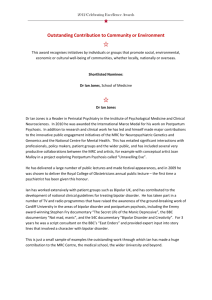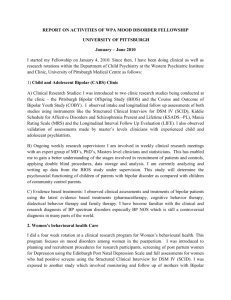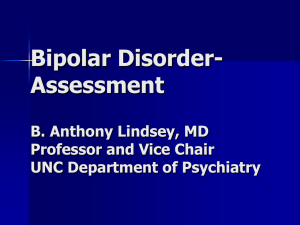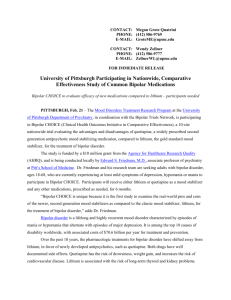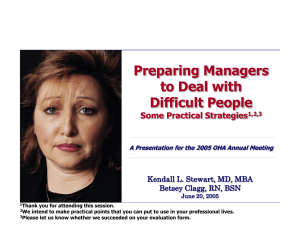What is natural history of Bipolar I Disorder?
advertisement
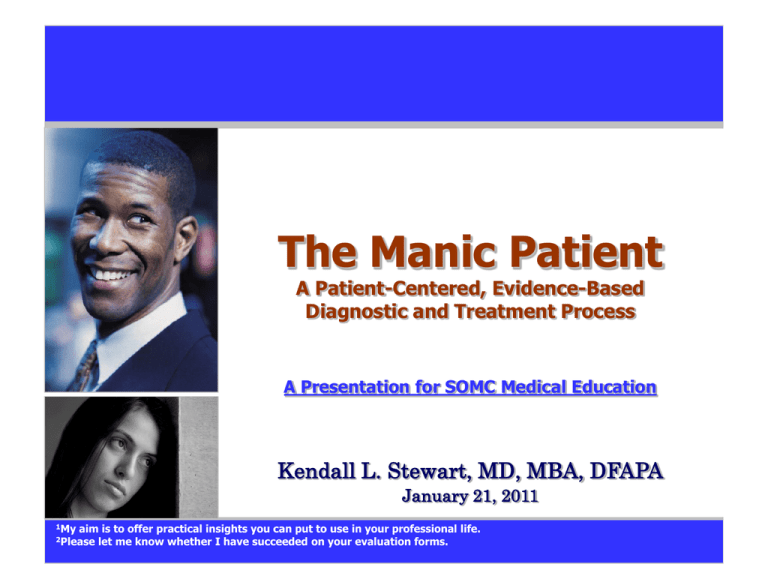
The Manic Patient A Patient-Centered, Evidence-Based Diagnostic and Treatment Process A Presentation for SOMC Medical Education Kendall L. Stewart, MD, MBA, DFAPA January 21, 2011 1My aim is to offer practical insights you can put to use in your professional life. let me know whether I have succeeded on your evaluation forms. 2Please Why is this important? • The lifetime risk of Bipolar Disorder is 1 to 2-percent. • The concordance rate is – 65 to 85-percent in monozygotic twins, and – 20-percent in dizygotic twins. • Bipolar illness occurs in relatives with bipolar disorder much more frequently. • The peak age of onset is between 20 and 25 years.1,2 • Mania responds better to treatment than does depression. • The prognosis depends on the severity of the underlying illness, the response to treatment and the patient’s compliance. 1A • After listening to this presentation, you will be able to answer the following questions: – Why is this important? – How do these patients present? – What are the diagnostic criteria? – What is the differential diagnosis? – What is the treatment? – What are some of the treatment challenges? history of hypomania in the patient who presents with recurrent depression is easy to miss. occurrence of a manic episode in older patients should raise concern about underlying organic pathology. 2The What specific diagnoses are included here? • Bipolar Disorders • • • • Bipolar I Disorder Bipolar II Disorder1 Cyclothymic Disorder Bipolar Disorder NOS • Mood Disorder due to General Medical Condition (GMC) • Substance-Induced Mood Disorder2 • Mood Disorder NOS 1Be 2I sure to ask depressed patients and their families detailed questions about unrecognized hypomania. once treated a college professor who became floridly manic after being dosed with steroids. What is natural history of Bipolar I Disorder? 10 8 6 4 2 Normal 0 Life Week 1 Week 2 Week 3 Week 4 Week 5 Week 6 Week 7 Week 8 -2 -4 -6 -8 -10 Symptom Intensity Scale Week 9 Week 10 Week 11 Week 12 What is natural history of Bipolar II Disorder? 10 8 6 4 2 Normal 0 Life Week 1 Week 2 Week 3 Week 4 Week 5 Week 6 Week 7 Week 8 -2 -4 -6 -8 -10 Symptom Intensity Scale Week 9 Week 10 Week 11 Week 12 What is natural history of Cyclothymic Disorder? 10 8 6 4 2 Normal 0 Life Week 1 Week 2 Week 3 Week 4 Week 5 Week 6 Week 7 Week 8 -2 -4 -6 -8 -10 Symptom Intensity Scale Week 9 Week 10 Week 11 Week 12 How do these patients present? • A 27-year-old graduate student was brought to the ED by his fiancée. • “He’s had a personality change in the past two weeks.” • “He’s been more irritable and suspicious.” • “He has not slept at all for the past three nights.” • “He is convinced that his research thesis will become the ‘new bible of the computer age.’” • “Fearful that his ideas will be stolen, he has created a complicated secret code so that ‘only I and my prophets can understand the text.’” • “He’s been dressing in a bizarre way to keep secret agents from following him.”1,2,3 1These • The patient initially refused to speak with the physician, but then the patient saw that a syllable in the physician’s name was the Latin word for “trust.” • The patient then talked incessantly and incoherently about the project that would “rock the world.” • The patient was hoarse. • He was easily distracted by the ambient sounds in the ED. • He was incensed that the physician thought anything was wrong. • He only reluctantly agreed to come into the hospital because his fiancée was able to persuade him that he would be safe there. • Listen to a bipolar patient here. people can be very persuasive. of my patients was convinced that Crystal Gaye has stolen his country song. 3Sometimes truth is as strange as delusion. A patient said he had been working on an electric fence. 2One What are the diagnostic criteria? • A distinct period of expansive, elevated or irritable mood • Lasts at least one week or requires hospitalization • Three or more of the following have been present to a significant degree: – – – – – – – Inflated self-esteem Decreased need for sleep Increased talking Racing ideas Being more distractible Increased psychomotor activity Excessive involvement in pleasurable but risky activities • Not a mixed episode • Significant impairment • Not substance-induced. 1Manic patients are a challenge to interview. Listen attentively for a time with emotional detachment. Don’t argue. Watch for sudden irritability. Keep interviews short. Get the history from family members. 2Manic patients demand immediate attention. I was attending a hospital picnic in the Black Hills. What associated features might you see? • Lack of insight • Resistance to treatment • Excessive, dramatic writing • Sexual experimentation1 • Increased religiosity • Increased spending • Increased irritability or hostility • Physical aggression 1A • Difficulties with the law • Reports of heightened senses • Catatonia • Abrupt shift in mood • Depressive symptoms • Mixed symptoms • Rapid cycling2 • Inappropriate behavior • Psychotic symptoms number of my manic patients have declared themselves homosexual only to be puzzled by that later when in remission. is coded when four or more mood episodes have occurred in the previous 12 months. 2This What is the differential diagnosis? • Normal elation – Winning the lottery1,2 • Other mood disorders – Bipolar II disorders – Cyclothymic Disorder – Bipolar Disorder NOS • Mania secondary to a general medical condition – Multiple sclerosis – Brain tumor – Cushing’s syndrome • Substance-induced mania – Cocaine • Grandiosity secondary to other psychiatric disorders – Schizophrenia – Paranoia 1Losing 2I can trigger a mood disorder too. was making rounds in the ICU at Mercy Hospital years ago, and observed a sad staff member. What is the treatment? • Mania – – – – – – – • Begin antipsychotic drugs Suicidal risk – – – • Reassure the Make sure the patient is safe. Consider hospitalization. Follow an evidence-based algorithm for the treatment of bipolar disorder. Consult a psychiatrist. Begin lithium carbonate 300 mg QID and titrate to therapeutic blood level.2 Consider another mood stabilizer or antipsychotic drug. Psychosis – • • family.1 Conduct a careful risk assessment. Document your assessment. Take appropriate precautions. Insomnia – 1During Consider the short-term use of your favorite sleeper if the antipsychotic drug does not do the trick. Other comorbid disorders – – • Maladaptive attitudes and behaviors – • Diagnose and treat these conditions vigorously. Be careful about using antidepressants since these may trigger rapid cycling. Counseling is not helpful during a full-blown manic episode. Education and self help – – – – – – – Provide educational resources. Recommend a daily exercise regimen. Recommend a healthy diet. Suggest healthy distractions. Recommend meditation. Recommend online resources with caution. Recommend self help groups with caution. a florid manic phase, these patients looks a lot sicker than they really are. lithium is the only effective drug against suicide. 2Remember, What are some of the treatment challenges? • These patients are notoriously non-compliant.1 • A trusting therapeutic relationship is your most effective tool.2 • These patient will regularly convince you they are fine; their families always know when they are getting manic, and family members always turn out to be right. • You only have a narrow window to start adjunctive antimanic medications. • Many of these patients do not respond to lithium alone. • You must follow lithium levels, TSH, BUN and creatinine levels regularly. • Untreated or inadequately-treated episodes result in worsening over time. • Relapses are harder to treat over time. • Their episodes of depression are much more difficult to treat. • Consider quetiapine or a combination of olanzapine and fluoxetine. 1A family physician colleague made a house call and found all of the medications he had previously prescribed. 2After many years of partial remission, a patient wanted to go off lithium and begin a herbal cure. The Psychiatric Interview A Patient-Centered, Evidence-Based Diagnostic and Therapeutic Process • • • • • • • • • • Introduce yourself using AIDET1. Sit down. Make me comfortable by asking some routine demographic questions. Ask me to list all of problems and concerns. Using my problem list as a guide, ask me clarifying questions about my current illness(es). Using evidence-based diagnostic criteria, make accurate preliminary diagnoses. Ask about my past psychiatric history. Ask about my family and social histories. Clarify my pertinent medical history. Perform an appropriate mental status examination. • • • • • • • • • • Review my laboratory data and other available records. Tell me what diagnoses you have made. Reassure me. Outline your recommended treatment plan while making sure that I understand. Repeatedly invite my clarifying questions. Be patient with me. Provide me with the appropriate educational resources. Invite me to call you with any additional questions I may have. Make a follow up appointment. Communicate with my other physicians. Acknowledge the patient. Introduce yourself. Inform the patient about the Duration of tests or treatment. Explain what is going to happen next. Thank your patients for the opportunity to serve them. 1 Where can you learn more? • • • • • • • • • 1,2Please American Psychiatric Association, Diagnostic and Statistical Manual of Mental Disorders, Fourth Edition, Text Revision, 2000 Sadock, B. J. and Sadock V. A., Concise Textbook of Clinical Psychiatry, Third Edition, 20081 Flaherty, AH, and Rost, NS, The Massachusetts Handbook of Neurology, April 20072 Stead, L, Stead, SM and Kaufman, M, First Aid© for the Psychiatry Clerkship, Second Edition, March 2005 Klamen, D, and Pan, P, Psychiatry Pre Test Self-Assessment and Review, Twelfth Edition, March 20093 Oransky, I, and Blitzstein, S, Lange Q&A: Psychiatry, March 2007 Ratey, JJ, Spark: The Revolutionary New Science of Exercise and the Brain, January 2008 Medina, John, Brain Rules: 12 Principles for Surviving and Thriving at Home, Work and School, February 2008 Stewart KL, “Dealing With Anxiety: A Practical Approach to Nervous Patients,” 2000 note that you must master all of the information in a basic neurology textbook and a basic psychiatry textbook to do well on the comprehensive, standardized final examination. Where can you find evidence-based information about mental disorders? • • • • • • • Explore the site maintained by the organization where evidence-based medicine began at McMaster University here. Sign up for the Medscape Best Evidence Newsletters in the specialties of your choice here. Subscribe to Evidence-Based Mental Health and search a database at the National Registry of Evidence-Based Programs and Practices maintained by the Substance Abuse and Mental Health Services Administration here. Explore a limited but useful database of mental health practices that have been "blessed" as evidence-based by various academic, administrative and advocacy groups collected by the Iowa Consortium for Mental Health here. Download this presentation and related presentations and white papers at www.KendallLStewartMD.com. Learn more about Southern Ohio Medical Center and the job opportunities there at www.SOMC.org. Review the exceptional medical education training opportunities at Southern Ohio Medical Center here. How can you contact me?1 Kendall L. Stewart, M.D. VPMA and Chief Medical Officer Southern Ohio Medical Center Chairman & CEO The SOMC Medical Care Foundation, Inc. 1805 27th Street Waller Building Suite B01 Portsmouth, Ohio 45662 740.356.8153 StewartK@somc.org KendallLStewartMD@yahoo.com www.somc.org www.KendallLStewartMD.com 1Speaking and consultation fees benefit the SOMC Endowment Fund. Are there other questions? Terry Johnson, DO OUCOM 1991 www.somc.org Ryan Foor, DO OUCOM 2005 Safety Quality Service Relationships Performance


